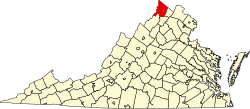Albin, Virginia | |
|---|---|
| Coordinates: 39°13′18″N78°11′55″W / 39.22167°N 78.19861°W | |
| Country | United States |
| State | Virginia |
| County | Frederick |
| Time zone | UTC−5 (Eastern (EST)) |
| • Summer (DST) | UTC−4 (EDT) |
| GNIS feature ID | 1499046 [1] |
Albin is an unincorporated community in Frederick County, Virginia, United States. Albin lies to the northwest of Winchester on North Frederick Pike (U.S. Highway 522). It was also known as Bryarly.


